Aztec mythology, a rich tapestry of intricate tales and characters, forms an integral part of the historical and cultural fabric of ancient Mesoamerican civilization. Among its pantheon stands Huehuecoyotl, a multifaceted deity renowned as the trickster god. Emblematic of mischief and unpredictability, Huehuecoyotl embodies a complex spectrum of attributes, from humor and joviality to cunning and capriciousness. This article delves into the enigmatic world of Huehuecoyotl, exploring his origins, myths, and enduring influence, offering a unique window into the Aztec understanding of balance and duality in the cosmos. Through this exploration, we aim to unveil not just the mythology surrounding this intriguing deity, but also the cultural and philosophical underpinnings that he represents in the vast and vibrant tapestry of Aztec lore.
| Attribute | Huehuecoyotl Information |
|---|---|
| Origin | Aztec Mythology |
| Deity Type | God of Music, Dance, and Mischief |
| Role | God associated with music, dance, art, and mischief |
| Trickster God | Often depicted as a playful and mischievous deity, similar to a trickster |
| Cultural Impact | A significant figure in Aztec culture, symbolizing creativity and playfulness |
| Depictions | Featured in Aztec art and rituals, often as a coyote-like figure with musical instruments |
1. Historical Context and Origins
The Aztec Civilization: An Overview
The Aztec Empire, flourishing from the 14th to the 16th century, was a beacon of power and culture in Mesoamerica. Centered in the Valley of Mexico, the empire extended its influence through a combination of military conquest and strategic alliances. At its zenith, it encompassed diverse peoples and lands, creating a melting pot of cultures and traditions. The Aztecs are celebrated for their architectural feats, complex calendar system, and rich mythological and religious beliefs, which were intricately woven into their daily lives.
Huehuecoyotl: The Trickster God’s Origins
In this vibrant cultural milieu, Huehuecoyotl emerged as a prominent figure in Aztec mythology. His name, often translated as “Old, Old Coyote,” resonates with the trickery and wisdom associated with coyotes in many native traditions. Unlike gods of sun and war that dominated the Aztec pantheon, Huehuecoyotl was a deity of art, dance, music, and mischief. His role extended beyond mere entertainment, touching upon the themes of fate, balance, and the unpredictability of life.
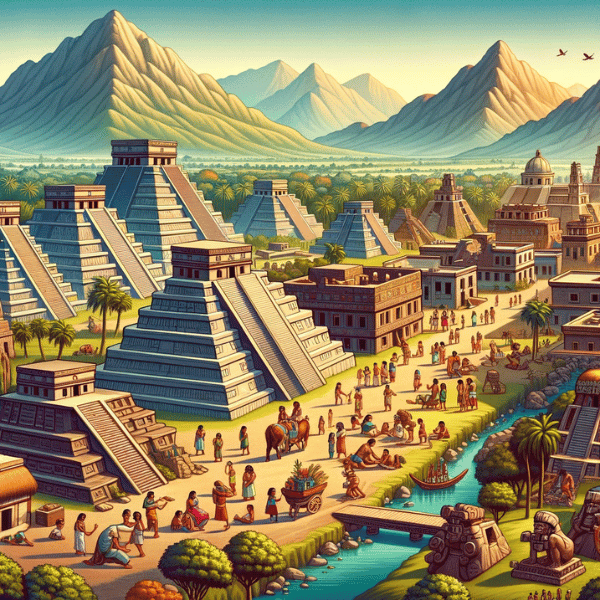
Trickster Gods Across Cultures
Huehuecoyotl’s trickster persona is not unique but finds echoes in various world mythologies. Norse mythology’s Loki, the cunning shapeshifter; Greek mythology’s Hermes, the clever messenger; and Native American tales’ Coyote, a figure of both wisdom and folly, all share traits with Huehuecoyotl. These deities, much like Huehuecoyotl, play roles that transcend the mere comic relief, often acting as catalysts for change, challenging the status quo, and revealing deeper truths through their antics. This comparative analysis not only broadens our understanding of Huehuecoyotl but also offers insight into the universal role of trickster gods in human consciousness and cultural narratives.
2. The Mythology of Huehuecoyotl
The Tales of Huehuecoyotl
Huehuecoyotl’s mythology is rich with tales that highlight his multifaceted personality. One of the most renowned stories depicts him orchestrating a humorous yet chaotic sequence of events during a banquet of the gods, revealing his ability to disrupt the divine order playfully. In another tale, he tricks an arrogant noble, teaching him a lesson in humility. These narratives underscore Huehuecoyotl’s role as both a disruptor and an educator, using mischief as a tool to impart wisdom and maintain cosmic balance.
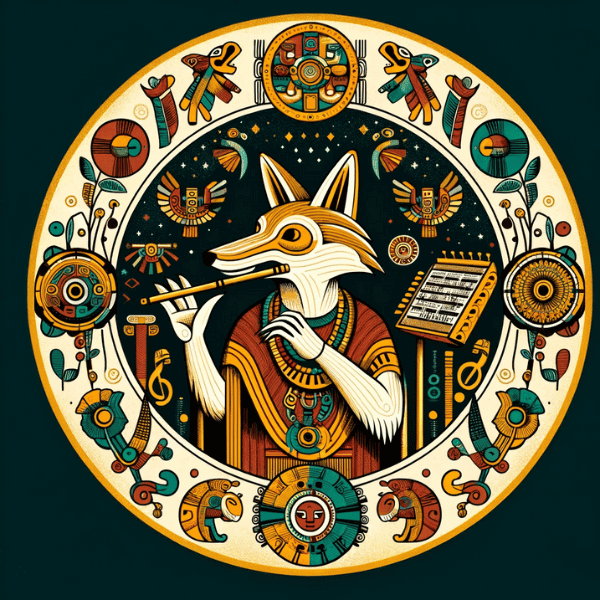
The Duality of Huehuecoyotl: Humor and Malevolence
Huehuecoyotl’s character is a study in contrasts. On one hand, he is the life of divine parties, revered for bringing joy and laughter. On the other, he is capable of deceit and malevolence, often leading others into trouble or danger for his amusement. This duality is reflective of the Aztec belief in the balance of opposites: creation and destruction, life and death, joy and sorrow. Huehuecoyotl, in his actions, embodies the unpredictable nature of existence itself.
Symbolism and Lessons from Huehuecoyotl’s Myths
The symbolism in Huehuecoyotl’s myths is profound. He often serves as a reminder of the impermanence and unpredictability of life. Through his stories, the Aztecs conveyed essential life lessons: the importance of humility, the inevitability of fate, and the value of joy in the face of life’s uncertainties. Huehuecoyotl, in his complexity, represents the idea that wisdom and folly can coexist, teaching us to embrace life’s multifarious experiences.
3. Representation and Iconography
Depicting Huehuecoyotl in Aztec Art
In Aztec art, Huehuecoyotl is distinctively portrayed with features that encapsulate his trickster essence. Typically depicted as a coyote, either wholly animalistic or anthropomorphized with human-like qualities, he often bears a jovial, even mischievous expression. His representations in sculptures, codices, and murals frequently highlight his role in music and dance, with instruments like drums and flutes being common accompaniments. These artistic depictions not only serve as a testament to Huehuecoyotl’s significance in Aztec culture but also offer a visual narrative of his character and attributes.
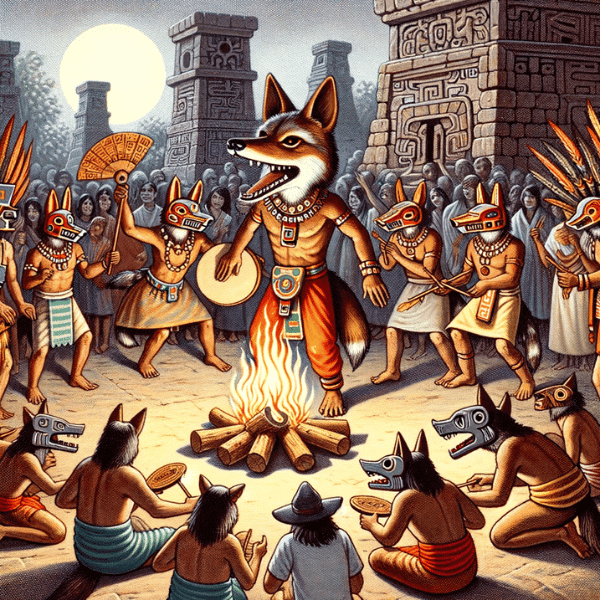
Symbols and Their Meanings
Several symbols are intrinsically linked to Huehuecoyotl, each carrying deep meanings. The coyote, his primary symbol, represents cunning and adaptability, reflecting Huehuecoyotl’s ability to navigate complex situations. Musical instruments, especially the flute, symbolize the joy and artistry he brings to the gods and humans alike. Occasionally, depictions include elements like fire or dual faces, hinting at his transformative nature and the duality of his personality. Understanding these symbols provides insight into how the Aztecs perceived and internalized the lessons and traits of Huehuecoyotl.
4. Huehuecoyotl’s Influence on Aztec Society
The Role of Huehuecoyotl in Aztec Life
Huehuecoyotl’s influence permeated various aspects of Aztec society, transcending the boundaries of myth and religion. As a deity associated with life’s dualities, he played a crucial role in the Aztec understanding of the world’s balance. His representation of change and unpredictability was a constant reminder of the fluid nature of life, encouraging adaptability and resilience among the Aztecs. Additionally, his association with music and dance underscored the cultural emphasis on these art forms as essential elements of worship and communal life.
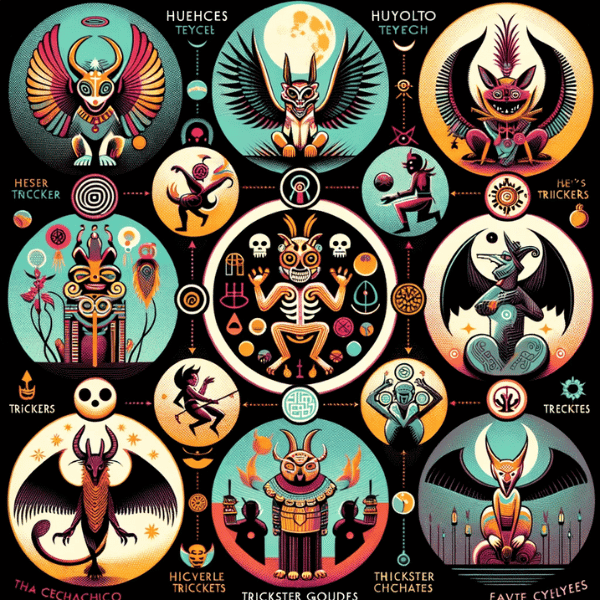
Rituals and Celebrations in Honor of Huehuecoyotl
Rituals and festivals dedicated to Huehuecoyotl were significant events in the Aztec calendar. These ceremonies often involved music, dance, and feasting, reflecting the joyful aspects of the deity. Priests and worshippers donned masks and costumes that emulated the coyote, symbolically embracing the god’s characteristics. These festivities were not merely celebratory; they were also a form of reverence and appeasement, ensuring that Huehuecoyotl’s capricious nature did not manifest in harmful ways. Such rituals highlight the deep connection the Aztecs had with their deities, viewing them as integral to the maintenance of cosmic order and societal well-being.
5. Comparative Mythology
Huehuecoyotl and Global Trickster Deities
Huehuecoyotl’s trickster archetype finds parallels in various cultures, illustrating a fascinating aspect of comparative mythology. In Greek mythology, Hermes exhibits similar cunning and cleverness. Like Huehuecoyotl, Hermes plays the role of a messenger, bridging the divine and mortal worlds with wit and intelligence. Norse mythology’s Loki, known for his shapeshifting and deceptive nature, also shares traits with Huehuecoyotl, particularly in his ability to disrupt the divine order for his own amusement or benefit.
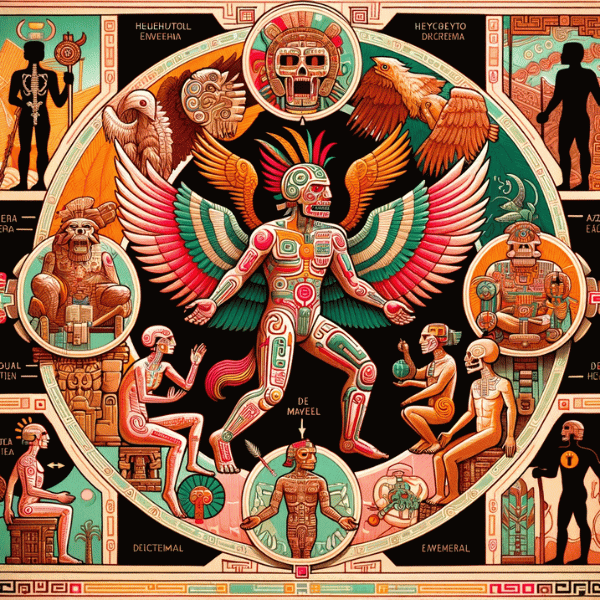
Universal Themes and Archetypes
Trickster gods like Huehuecoyotl represent universal themes and archetypes prevalent across different cultures. They symbolize the unpredictability of life and the necessity of change and adaptation. Often seen as boundary-crossers, tricksters challenge established norms and provoke thought, leading to transformation and evolution. Their stories, while entertaining, carry profound philosophical and psychological meanings, reflecting the complexities of human nature and the world. These deities often serve as cultural catalysts, embodying the chaos that precedes creation and the necessary balance between order and disorder in the universe.
6. Conclusion
In conclusion, Huehuecoyotl stands as a captivating figure in Aztec mythology, embodying the essence of the trickster god with depth and complexity. His narratives, rich with humor, cunning, and wisdom, offer a unique perspective on the Aztec worldview – one that embraces the unpredictability and duality of life. Huehuecoyotl’s depiction in art and his integral role in societal rituals and festivals underline his importance in Aztec culture, serving as a bridge between the divine and the mundane. Comparisons with similar deities across various mythologies highlight not only the distinctiveness of Aztec beliefs but also the universal themes trickster gods represent in human consciousness. Ultimately, Huehuecoyotl is more than just a mythological character; he is a symbol of life’s inherent uncertainties and a reminder of the perpetual balance between chaos and order.
